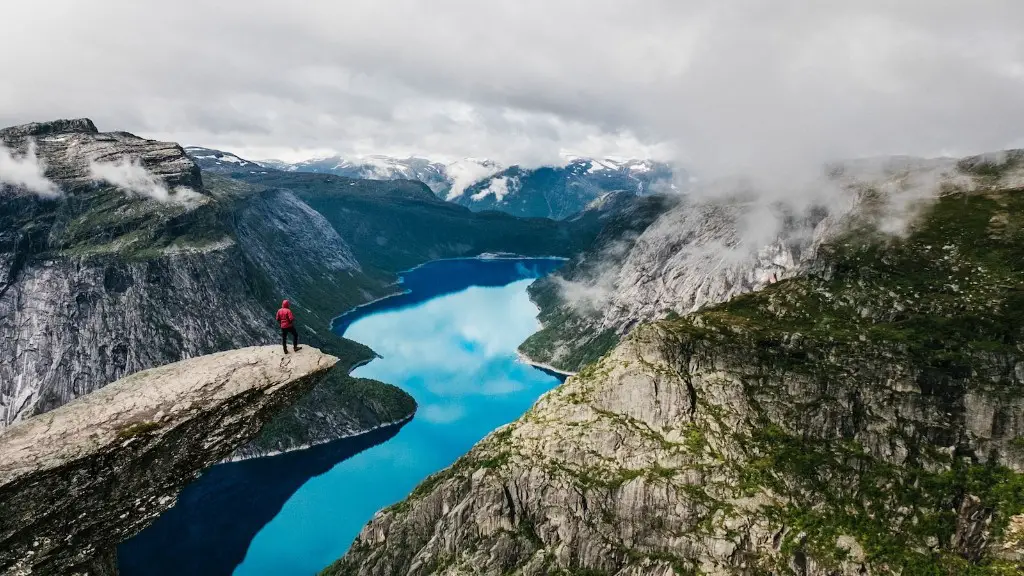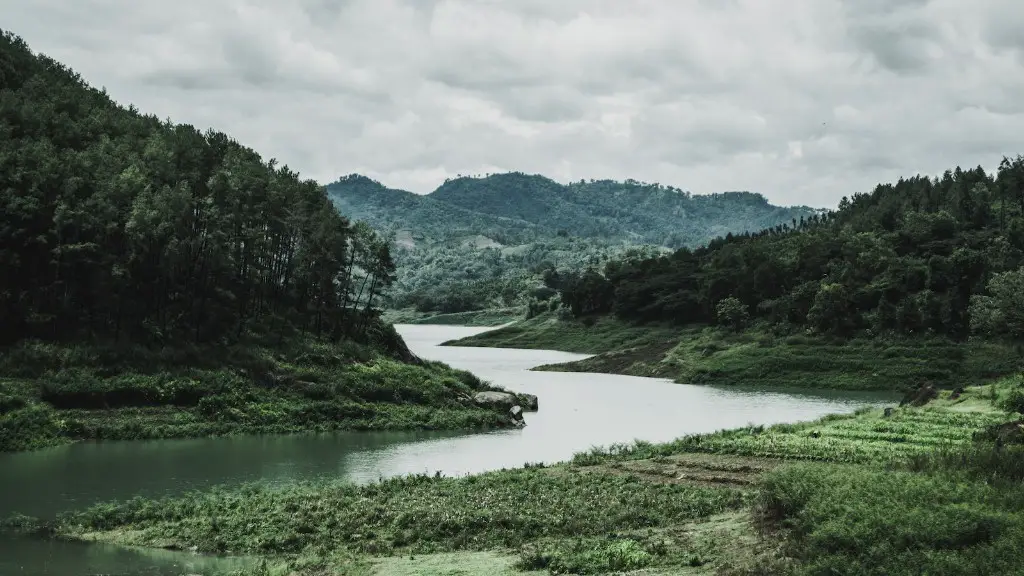The Mississippi River is one of the world’s most important waterways. It stretches from it’s source in Minnesota, across Illinois and through the Mississippi delta before entering the Gulf of Mexico. Nearly half of the continental United States is drained by the Mississippi River. But how did the Mississippi River itself begin?
Geologists believe that the starting point of the Mississippi River lies in Lake Itasca, located in central Minnesota. Its surface elevation is 646 feet above sea level and it is considered to be the official “headwaters” of the Mississippi River. The river runs over 2,300 miles and drains water from 31 states and two provinces, making it one of the longest rivers in the world.
The beginnings of the Mississippi River can be traced back to the Paleozoic and Mesozoic Eras. During these eras, massive floods carved the landscape of the Central United States, forming large river valleys and eventually, the Mississippi River. The river follows a meandering path and is constantly changing due to the erosive forces of the water.
Throughout its journey, the Mississippi picks up some of the most nutrient-rich soil in the world. This soil is then deposited along the banks of the river, where it provides a much-needed source of fertility to the surrounding region. The fertility of the states and provinces along the river is one of the major reasons why the Mississippi remains an important waterway for commerce, agriculture and leisure.
The Mississippi River is continually supplying valuable resources to the surrounding area, but the river has also faced many obstacles over the years. Flooding, over-fertilization and poor water management have all impacted the health of the river. In recent years, there has been increased investment in restoring the river, but it still faces many challenges.
The Mississippi River is a vital natural resource and its importance to the region and the world cannot be overstated. It is essential to understand the journey the river has taken since its beginnings in Lake Itasca, in order to best protect and maintain it in the future.
Flow of the Mississippi Through Time
The current flow of the Mississippi River is the product of hundreds of years of slow and steady modifications to the geography of the central United States. While the width and depth of the river remain mostly unchanged, the trajectory and patterns of its flow have been ever-changing.
The first significant modification to the flow of the Mississippi River was made in the mid-1800s by engineer James B. Eads. Eads’ vision was to stabilize the river and clear it of sandbars and snags, which had made navigation especially difficult. To achieve this, he constructed a series of levees and canals throughout the central region, drastically altering the course of the river.
By the start of the 20th century, the Mississippi River had become a major transportation corridor for goods and services between the eastern and western parts of the United States. These transportation needs eventually led to the creation of the Mississippi River Commission, an organization designed to protect and improve river navigation. The Commission sought to control floods, promote navigation and secure the river’s banks.
The environmental challenges that the Mississippi River has faced in recent decades can be attributed in part to its tremendous importance as a transportation artery. Urbanization has increased water pollution, while commercial navigation and hydroelectric dams have caused a decrease in water quality and flow.
In recent years, there has been increased investment in restoring the health of the river. Improvements to wastewater treatment, measures to reduce runoff and riverbank restoration projects have all contributed to improving the water quality of the Mississippi.
Impact of the Mississippi on Society
The Mississippi River has been the lifeblood of many civilizations over the centuries. Past societies have built their economies, their cultures and their lifestyles around its powerful flow.
The river is responsible for the rise of many of the cities that line its banks, from St. Louis to Vicksburg. The river itself has also been the catalyst for much of the economic activity in the United States. The industrial centers that emerged along its banks both benefitted from and depended on the transportation and resources afforded by the river.
The cultural impact of the Mississippi River and its various tributaries cannot be overlooked either. Its lush floodplains were an ideal habitat for Native American tribes who once populated the region. Its waters were the stage for some of the most significant events in US history, from the steamboats of the 1800s to the grand river festivals of the 20th century. To this day, the Mississippi remains an integral part of US culture and identity.
The Mississippi River is a national treasure and its importance to the United States and the entire world cannot be understated. Protecting and preserving the river is a responsibility that must be taken seriously, if future generations are to benefit from its immense potential.
Environmental Challenges of the Mississippi
The Mississippi River carries a large amount of pollution along its journey from the headwaters in Minnesota to the Gulf of Mexico. As it winds through the central United States, the river collects all sorts of pollutants, from industrial and agricultural runoff to sewage and other wastewater.
These pollutants can cause a wide range of environmental issues, from algal blooms that are toxic to fish and other aquatic species, to increased river sedimentation that can lead to loss of habitat for many species. Pollution also has a negative impact on the quality of drinking water, which can harm human health as well as the environment.
The Mississippi River is home to many species of fish and other aquatic wildlife. Pollution can lead to the decline of these species, as well as have a negative effect on recreational activities and aesthetics along the river. There have been some efforts to reduce the pollution of the river and its tributaries, including the implementation of stricter regulations and the development of cleaner technologies.
The preservation of the Mississippi River will require a concerted effort from all stakeholders. To ensure the river’s health in the future, it is important to reduce pollution, improve water management and restore the river’s banks in order to protect and enhance the ecosystems that depend on it.
Economic Impact of the Mississippi
The Mississippi River is the backbone of the US economy. It provides a vital source of transportation, irrigation, navigation and hydropower. It is also a major source of drinking water and many other resources.
The Mississippi River system has long been a hub for shipping and commerce, from the exploration of the Louisiana Purchase to the grain barges traveling from Illinois to New Orleans today. The river also allows for access to an abundant resource of fresh water for drinking and irrigation, which is essential for agricultural production.
The river also provides sustenance for many people living near its banks. Along the Mississippi, fishermen, oystermen and hunters rely on the river for their livelihoods. The delta region is also a popular destination for ecotourism and bird watching.
For many people, the Mississippi River is also an important part of their history and culture. The river is home to many iconic cities, such as Memphis and New Orleans, where a unique blend of music, dance and food have become part of the culture of the region.
The Mississippi River is one of the most important rivers in the world and its importance to the economy and culture of the United States cannot be overstated. Protecting and preserving the river is essential in order for it to remain a vital force for generations to come.
Conclusion
The Mississippi River has been a source of life, sustenance, and commerce for thousands of years. Its origin can be traced back to Lake Itasca, in Minnesota, and its journey has been shaped by floods and the erosion of the landscape to its current form. Although the river has faced many environmental and economic challenges, its importance to the region and the world cannot be overstated.
The Mississippi River is an integral part of US culture, economy and identity. It provides sustenance, transportation, and recreation to the millions of people living along its banks. Protecting and preserving the river for the future requires a concerted effort from all stakeholders in order to ensure that the river’s potential is realized for generations to come.





